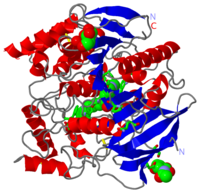TORPEDO CALIFORNICA ACETYLCHOLINESTERASE COMPLEXED WITH ALKYLENE-LINKED BIS-TACRINE DIMER (7 CARBON LINKER)
(see also AChE bivalent inhibitors)
Publication Abstract from PubMed
The X-ray crystal structures were solved for complexes with Torpedo californica acetylcholinesterase of two bivalent tacrine derivative compounds in which the two tacrine rings were separated by 5- and 7-carbon spacers. The derivative with the 7-carbon spacer spans the length of the active-site gorge, making sandwich interactions with aromatic residues both in the catalytic anionic site (Trp84 and Phe330) at the bottom of the gorge and at the peripheral anionic site near its mouth (Tyr70 and Trp279). The derivative with the 5-carbon spacer interacts in a similar manner at the bottom of the gorge, but the shorter tether precludes a sandwich interaction at the peripheral anionic site. Although the upper tacrine group does interact with Trp279, it displaces the phenyl residue of Phe331, thus causing a major rearrangement in the Trp279-Ser291 loop. The ability of this inhibitor to induce large-scale structural changes in the active-site gorge of acetylcholinesterase has significant implications for structure-based drug design because such conformational changes in the target enzyme are difficult to predict and to model.
Complexes of alkylene-linked tacrine dimers with Torpedo californica acetylcholinesterase: Binding of Bis5-tacrine produces a dramatic rearrangement in the active-site gorge., Rydberg EH, Brumshtein B, Greenblatt HM, Wong DM, Shaya D, Williams LD, Carlier PR, Pang YP, Silman I, Sussman JL, J Med Chem. 2006 Sep 7;49(18):5491-500. PMID:16942022
From MEDLINE®/PubMed®, a database of the U.S. National Library of Medicine.
2d and 2f are bis(n)-tacrine derivatives with n=5 and 7 (number of carbons in the linkers), respectively. These compounds are more potent and selective AChE inhibitors than tacrine alone. The binding of the first tacrine moiety of at the TcAChE catalytic anionic site (CAS) is similar to that of tacrine alone (1acj). The second tacrine moiety of the 2d interacts with peripheral anionic site (PAS) near the Trp279. The interaction of 2d at CAS caused increase of the between Ser200 Oγ and H440 Nε2 atoms, and, therefore, disruption of the catalytic triad (Ser200, H220, E327) compared with the native structure (2ace). This binding results in in the Val281-Ser291 loop causing a significant change in the surface of the active-site gorge in comparison to the native structure (2ace). The first tacrine moiety of the compound 2f (heptylene-linked bis-tacrine, 2ckm) also adopts similar as tacrine alone and the first tacrine moiety of the 2d at the CAS. The second tacrine moiety of the 2f interacts with PAS near the Trp279, similar to 2d. The of the 2f does not cause significant structural changes in the TcAChE upon forming the complex in comparison to the native TcAChE structure. of the 2d and 2f reveals different contacts between the second tacrine moieties of these compounds and TcAChE. There are two additional structures of complexes of TcAChE with tacrine-containing AChE inhibitors: compounds (1ut6) and (1odc). The tacrine moieties of these compounds display similar conformations and interactions with CAS as tacrine alone, 2d and 2f. Both inhibitors 6 and 7 are spanning the from the CAS up to the PAS, but since compound 7 lacks the second tacrine moiety, Trp279 adopts a different conformation in this complex structure. In the three structures: native (cyan), TcAChE-cmp 6 complex (white), and TcAChE-cmp 7 complex (crimson) , except of Trp279, all the other TcAChE active-site gorge residues have similar conformations.
About this Structure
2CKM is a 1 chain structure of sequence from Torpedo californica. Full crystallographic information is available from OCA.
Additional Resources
For additional information, see: Alzheimer's Disease

